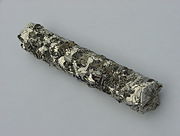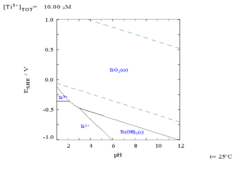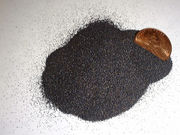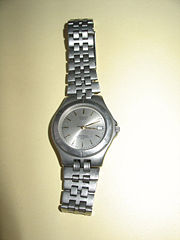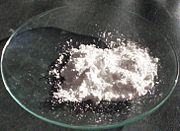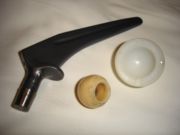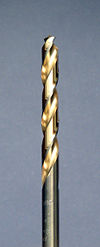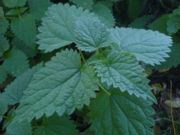Titanium
2008/9 Schools Wikipedia Selection. Related subjects: Chemical elements
|
||||||||||||||||||||||||||||||||||||||||||||||
| General | ||||||||||||||||||||||||||||||||||||||||||||||
|---|---|---|---|---|---|---|---|---|---|---|---|---|---|---|---|---|---|---|---|---|---|---|---|---|---|---|---|---|---|---|---|---|---|---|---|---|---|---|---|---|---|---|---|---|---|---|
| Name, symbol, number | titanium, Ti, 22 | |||||||||||||||||||||||||||||||||||||||||||||
| Chemical series | transition metals | |||||||||||||||||||||||||||||||||||||||||||||
| Group, period, block | 4, 4, d | |||||||||||||||||||||||||||||||||||||||||||||
| Appearance | silvery grey-white metallic |
|||||||||||||||||||||||||||||||||||||||||||||
| Standard atomic weight | 47.867 (1) g·mol−1 | |||||||||||||||||||||||||||||||||||||||||||||
| Electron configuration | [Ar] 3d2 4s2 | |||||||||||||||||||||||||||||||||||||||||||||
| Electrons per shell | 2, 8, 8, 4 | |||||||||||||||||||||||||||||||||||||||||||||
| Physical properties | ||||||||||||||||||||||||||||||||||||||||||||||
| Phase | solid | |||||||||||||||||||||||||||||||||||||||||||||
| Density (near r.t.) | 4.506 g·cm−3 | |||||||||||||||||||||||||||||||||||||||||||||
| Liquid density at m.p. | 4.11 g·cm−3 | |||||||||||||||||||||||||||||||||||||||||||||
| Melting point | 1941 K (1668 ° C, 3034 ° F) |
|||||||||||||||||||||||||||||||||||||||||||||
| Boiling point | 3560 K (3287 ° C, 5949 ° F) |
|||||||||||||||||||||||||||||||||||||||||||||
| Heat of fusion | 14.15 kJ·mol−1 | |||||||||||||||||||||||||||||||||||||||||||||
| Heat of vaporization | 425 kJ·mol−1 | |||||||||||||||||||||||||||||||||||||||||||||
| Specific heat capacity | (25 °C) 25.060 J·mol−1·K−1 | |||||||||||||||||||||||||||||||||||||||||||||
|
||||||||||||||||||||||||||||||||||||||||||||||
| Atomic properties | ||||||||||||||||||||||||||||||||||||||||||||||
| Crystal structure | hexagonal | |||||||||||||||||||||||||||||||||||||||||||||
| Oxidation states | 4, 3, 2, 1 ( amphoteric oxide) |
|||||||||||||||||||||||||||||||||||||||||||||
| Electronegativity | 1.54 (Pauling scale) | |||||||||||||||||||||||||||||||||||||||||||||
| Ionization energies ( more) |
1st: 658.8 kJ·mol−1 | |||||||||||||||||||||||||||||||||||||||||||||
| 2nd: 1309.8 kJ·mol−1 | ||||||||||||||||||||||||||||||||||||||||||||||
| 3rd: 2652.5 kJ·mol−1 | ||||||||||||||||||||||||||||||||||||||||||||||
| Atomic radius | 140 pm | |||||||||||||||||||||||||||||||||||||||||||||
| Atomic radius (calc.) | 176 pm | |||||||||||||||||||||||||||||||||||||||||||||
| Covalent radius | 136 pm | |||||||||||||||||||||||||||||||||||||||||||||
| Miscellaneous | ||||||||||||||||||||||||||||||||||||||||||||||
| Magnetic ordering | paramagnetic | |||||||||||||||||||||||||||||||||||||||||||||
| Electrical resistivity | (20 °C) 0.420 µΩ·m | |||||||||||||||||||||||||||||||||||||||||||||
| Thermal conductivity | (300 K) 21.9 W·m−1·K−1 | |||||||||||||||||||||||||||||||||||||||||||||
| Thermal expansion | (25 °C) 8.6 µm·m−1·K−1 | |||||||||||||||||||||||||||||||||||||||||||||
| Speed of sound (thin rod) | ( r.t.) 5090 m·s−1 | |||||||||||||||||||||||||||||||||||||||||||||
| Young's modulus | 116 GPa | |||||||||||||||||||||||||||||||||||||||||||||
| Shear modulus | 44 GPa | |||||||||||||||||||||||||||||||||||||||||||||
| Bulk modulus | 110 GPa | |||||||||||||||||||||||||||||||||||||||||||||
| Poisson ratio | 0.32 | |||||||||||||||||||||||||||||||||||||||||||||
| Mohs hardness | 6.0 | |||||||||||||||||||||||||||||||||||||||||||||
| Vickers hardness | 970 MPa | |||||||||||||||||||||||||||||||||||||||||||||
| Brinell hardness | 716 MPa | |||||||||||||||||||||||||||||||||||||||||||||
| CAS registry number | 7440-32-6 | |||||||||||||||||||||||||||||||||||||||||||||
| Selected isotopes | ||||||||||||||||||||||||||||||||||||||||||||||
|
||||||||||||||||||||||||||||||||||||||||||||||
| References | ||||||||||||||||||||||||||||||||||||||||||||||
Titanium (pronounced /taɪˈteɪniəm/) is a chemical element with the symbol Ti and atomic number 22. It is a light, strong, lustrous, corrosion-resistant (including to sea water and chlorine) transition metal with a grayish colour. Titanium can be alloyed with iron, aluminium, vanadium, molybdenum, among other elements, to produce strong lightweight alloys for aerospace (jet engines, missiles, and spacecraft), military, industrial process (chemicals and petro-chemicals, desalination plants, pulp and paper), automotive, agri-food, medical ( prostheses, orthopaedic implants, dental implants), sporting goods, jewelry, and other applications. Titanium was discovered in England by William Gregor in 1791 and named by Martin Heinrich Klaproth for the Titans of Greek mythology.
The element occurs within a number of mineral deposits, principally rutile and ilmenite, which are widely distributed in the Earth's crust and lithosphere, and it is found in almost all living things, rocks, water bodies and soils. The metal is extracted from its principal mineral ores via the Kroll process, or the Hunter process. Its most common compound, titanium dioxide, is used in the manufacture of white pigments. Other compounds include titanium tetrachloride (TiCl4) (used in smoke screens/ skywriting and as a catalyst) and titanium trichloride (used as a catalyst in the production of polypropylene).
The two most useful properties of the metal form are corrosion resistance, and the highest strength-to-weight ratio of any metal. In its unalloyed condition, titanium is as strong as some steels, but 45% lighter. There are two allotropic forms and five naturally occurring isotopes of this element; 46Ti through 50Ti with 48Ti being the most abundant (73.8%). Titanium's properties are chemically and physically similar to zirconium.
History
Titanium was discovered combined in a mineral in Cornwall, England in 1791 by amateur geologist and pastor William Gregor, the then vicar of Creed parish. He recognized the presence of a new element in ilmenite when he found black sand by a stream in the nearby parish of Manaccan and noticed the sand was attracted by a magnet. Analysis of the sand determined the presence of two metal oxides; iron oxide (explaining the attraction to the magnet) and 45.25% of a white metallic oxide he could not identify. Gregor, realizing that the unidentified oxide contained a metal that did not match the properties of any known element, reported his findings to the Royal Geological Society of Cornwall and in the German science journal Crell's Annalen.

Around the same time, Franz Joseph Muller also produced a similar substance, but could not identify it. The oxide was independently rediscovered in 1795 by German chemist Martin Heinrich Klaproth in rutile from Hungary. Klaproth found that it contained a new element and named it for the Titans of Greek mythology. After hearing about Gregor's earlier discovery, he obtained a sample of manaccanite and confirmed it contained titanium.
The processes required to extract titanium from its various ores are laborious and costly; it is not possible to reduce in the normal manner, by heating in the presence of carbon, because that produces titanium carbide. Pure metallic titanium (99.9%) was first prepared in 1910 by Matthew A. Hunter by heating TiCl4 with sodium in a steel bomb at 700–800 °C in the Hunter process. Titanium metal was not used outside the laboratory until 1946 when William Justin Kroll proved that it could be commercially produced by reducing titanium tetrachloride with magnesium in what came to be known as the Kroll process. Although research continues into more efficient and cheaper processes ( FFC Cambridge, e.g.), the Kroll process is still used for commercial production.
Titanium of very high purity was made in small quantities when Anton Eduard van Arkel and Jan Hendrik de Boer discovered the iodide, or crystal bar, process in 1925, by reacting with iodine and decomposing the formed vapors over a hot filament to pure metal.
In the 1950s and 1960s the Soviet Union pioneered the use of titanium in military and submarine applications ( Alfa Class and Mike Class) as part of programs related to the Cold War. Starting in the early 1950s, Titanium began to be used extensively for military aviation purposes, particularly in high-performance jets, starting with aircraft such as the F100 Super Sabre and Lockheed A-12.
In the USA, the Department of Defense realized the strategic importance of the metal and supported early efforts of commercialization. Throughout the period of the Cold War, titanium was considered a Strategic Material by the U.S. government, and a large stockpile of titanium sponge was maintained by the Defense National Stockpile Centre, which was finally depleted in 2005. Today, the world's largest producer, Russian-based VSMPO-Avisma, is estimated to account for about 29% of the world market share.
In 2006, the U.S. Defense Agency awarded $5.7 million to a two-company consortium to develop a new process for making titanium metal powder. Under heat and pressure, the powder can be used to create strong, lightweight items ranging from armor plating to components for the aerospace, transportation and chemical processing industries.
Characteristics
Physical
A metallic element, titanium is recognized for its high strength-to-weight ratio. It is a light, strong metal with low density that, when pure, is quite ductile (especially in an oxygen-free environment), lustrous, and metallic-white in colour. The relatively high melting point (over 1,649 °C or 3,000 °F) makes it useful as a refractory metal.
Commercial (99.2% pure) grades of titanium have ultimate tensile strength of about 63,000 psi (434 MPa), equal to that of some steel alloys, but are 45% lighter. Titanium is 60% heavier than aluminium, but more than twice as strong as the most commonly used 6061-T6 aluminium alloy. Certain titanium alloys (e.g., Beta C) achieve tensile strengths of over 200,000 psi (1380 MPa). However, titanium loses strength when heated above 430 °C (800 °F).
It is fairly hard (although not as hard as some grades of heat-treated steel) and is difficult to machine, as it will gall if sharp tools and proper cooling methods are not used. Like those made from steel, titanium structures have a fatigue limit which guarantees longevity in some applications.
The metal is a dimorphic allotrope with the hexagonal alpha form changing into the body-centered cubic (lattice) beta form at 882 °C (1,619 °F). The heat capacity of the alpha form increases dramatically as it is heated to this transition temperature but then falls and remains fairly constant for the beta form regardless of temperature.
Chemical
The most noted chemical property of titanium is its excellent resistance to corrosion; it is almost as resistant as platinum, capable of withstanding attack by acids, moist chlorine gas, and by common salt solutions. Pure titanium is not soluble in water but is soluble in concentrated acids.
While the following pourbaix diagram shows that titanium is thermodynamically a very reactive metal, it is slow to react with water and air.
This metal forms a passive and protective oxide coating (leading to increased corrosion-resistance) when exposed to elevated temperatures in air, but at room temperatures it resists tarnishing. When it first forms, this protective layer is only 1–2 nm thick but continues to slowly grow; reaching a thickness of 25 nm in four years.
Titanium burns when heated in air 610 °C (1,130 °F) or higher, forming titanium dioxide. It is also one of the few elements that burns in pure nitrogen gas (it burns at 800 °C or 1,472 °F and forms titanium nitride, which causes embrittlement). Titanium is resistant to dilute sulfuric and hydrochloric acid, along with chlorine gas, chloride solutions, and most organic acids. It is paramagnetic (weakly attracted to magnets) and has fairly low electrical and thermal conductivity.
Experiments have shown that natural titanium becomes radioactive after it is bombarded with deuterons, emitting mainly positrons and hard gamma rays. When it is red hot the metal combines with oxygen, and when it reaches 550 °C (1,022 °F) it combines with chlorine. It also reacts with the other halogens and absorbs hydrogen.
Occurrence
| Producer | Thousands of tons | % of total |
|---|---|---|
| Australia | 1291.0 | 30.6 |
| South Africa | 850.0 | 20.1 |
| Canada | 767.0 | 18.2 |
| Norway | 382.9 | 9.1 |
| Ukraine | 357.0 | 8.5 |
| Other countries | 573.1 | 13.6 |
| Total world | 4221.0 | 100.1 |
Due to rounding, values do not sum to 100%.
Titanium is always bonded to other elements in nature. It is the ninth-most abundant element in the Earth's crust (0.63% by mass) and the seventh-most abundant metal. It is present in most igneous rocks and in sediments derived from them (as well as in living things and natural bodies of water). In fact, of the 801 types of igneous rocks analyzed by the United States Geological Survey, 784 contained titanium. Its proportion in soils is approximately 0.5 to 1.5%.
It is widely distributed and occurs primarily in the minerals anatase, brookite, ilmenite, perovskite, rutile, titanite (sphene), as well in many iron ores. Of these minerals, only rutile and ilmenite have any economic importance, yet even they are difficult to find in high concentrations. Significant titanium-bearing ilmenite deposits exist in western Australia, Canada, New Zealand, Norway, and Ukraine. Large quantities of rutile are also mined in North America and South Africa and help contribute to the annual production of 90,000 tonnes of the metal and 4.3 million tonnes of titanium dioxide. Total known reserves of titanium are estimated to exceed 600 million tonnes.
Titanium is contained in meteorites and has been detected in the sun and in M-type stars; the coolest type of star with a surface temperature of 3,200 °C (5,792 °F). Rocks brought back from the moon during the Apollo 17 mission are composed of 12.1% TiO2. It is also found in coal ash, plants, and even the human body.
Production and fabrication
The processing of titanium metal occurs in 4 major steps: reduction of titanium ore into "sponge", a porous form; melting of sponge, or sponge plus a master alloy to form an ingot; primary fabrication, where an ingot is converted into general mill products such as billet, bar, plate, sheet, strip and tube; and secondary fabrication of finished shapes from mill products.
Because the metal reacts with oxygen at high temperatures it cannot be produced by reduction of its dioxide. Titanium metal is therefore produced commercially by the Kroll process, a complex and expensive batch process. (The relatively high market value of titanium is mainly due to its processing, which sacrifices another expensive metal, magnesium.) In the Kroll process, the oxide is first converted to chloride through carbochlorination, whereby chlorine gas is passed over red-hot rutile or ilmenite in the presence of carbon to make TiCl4. This is condensed and purified by fractional distillation and then reduced with 800 °C molten magnesium in an argon atmosphere.
A more recently developed method, the FFC Cambridge process, may eventually replace the Kroll process. This method uses titanium dioxide powder (which is a refined form of rutile) as feedstock to make the end product which is either a powder or sponge. If mixed oxide powders are used, the product is an alloy manufactured at a much lower cost than the conventional multi-step melting process. The FFC Cambridge Process may render titanium a less rare and expensive material for the aerospace industry and the luxury goods market, and could be seen in many products currently manufactured using aluminium and specialist grades of steel.
Common titanium alloys are made by reduction. For example; cuprotitanium (rutile with copper added is reduced), ferrocarbon titanium ( ilmenite reduced with coke in an electric furnace), and manganotitanium ( rutile with manganese or manganese oxides) are reduced.
About 50 grades of titanium and titanium alloys are designated and currently used, although only a couple of dozen are readily available commercially. The ASTM International recognizes 31 Grades of titanium metal and alloys, of which Grades 1 through 4 are commercially pure (unalloyed). These four are distinguished by their varying degrees of tensile strength, as a function of oxygen content, with Grade 1 being the most ductile (lowest tensile strength with an oxygen content of 0.18%), and Grade 4 the least (highest tensile strength with an oxygen content of 0.40%). The remaining grades are alloys, each designed for specific purposes, be it ductility, strength, hardness, electrical resistivity, creep resistance, resistance to corrosion from specific media, or a combination thereof.
The grades covered by ASTM and other alloys are also produced to meet Aerospace and Military specifications (SAE-AMS, MIL-T), ISO standards, and country-specific specifications, as well as proprietary end-user specifications for aerospace, military, medical and industrial applications.
In terms of fabrication, all welding of titanium must be done in an inert atmosphere of argon or helium in order to shield it from contamination with atmospheric gases such as oxygen, nitrogen or hydrogen. Contamination will cause a variety of conditions, such as embrittlement, which will reduce the integrity of the assembly welds and lead to joint failure. Commercially pure flat product (sheet, plate) can be formed readily, but processing must take into account the fact that the metal has a 'memory' and tends to spring back. This is especially true of certain high-strength alloys. The metal can be machined using the same equipment and via the same processes as stainless steel.
Applications
Titanium is used in steel as an alloying element ( ferro-titanium) to reduce grain size and as a deoxidizer, and in stainless steel to reduce carbon content. Titanium is often alloyed with aluminium (to refine grain size), vanadium, copper (to harden), iron, manganese, molybdenum, and with other metals. Applications for titanium mill products (sheet, plate, bar, wire, forgings, castings) can be found in industrial, aerospace, recreational and emerging markets. Powdered titanium is used in pyrotechnics as a source of bright-burning particles.
Titanium is used in watchmaking for the production of watch cases. Watchmakers appreciate titanium for its durability, light weight, dent- and corrosion- resistance. Titanium watches are often coated with a protective material to make the surface more scratch-resistant.
Pigments, Additives and Coatings
About 95% of titanium ore extracted from the Earth is destined for refinement into titanium dioxide (TiO2), an intensely white permanent pigment used in paints, paper, toothpaste, and plastics. It is also used in cement, in gemstones, as an optical opacifier in paper, and a strengthening agent in graphite composite fishing rods and golf clubs.
TiO2 powder is chemically inert, resists fading in sunlight, and is very opaque: this allows it to impart a pure and brilliant white colour to the brown or gray chemicals that form the majority of household plastics. In nature, this compound is found in the minerals anatase, brookite, and rutile. Paint made with titanium dioxide does well in severe temperatures, is somewhat self-cleaning, and stands up to marine environments. Pure titanium dioxide has a very high index of refraction and an optical dispersion higher than diamond.
Recently, it has been put to use in air purifiers (as a filter coating), or in film used to coat windows on buildings which when exposed to UV light (either solar or man-made) and moisture in the air produces reactive redox species like hydroxyl radicals that can purify the air or keep window surfaces clean.
Aerospace and marine
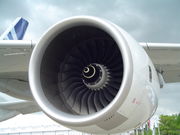
Due to their high tensile strength to density ratio, high corrosion resistance and ability to withstand moderately high temperatures without creeping, titanium alloys are used in aircraft, armor plating, naval ships, spacecraft and missiles. For these applications titanium alloyed with aluminium, vanadium and other elements are used for a variety of components including critical structural parts, fire walls, landing gear, exhaust ducts (helicopters) and hydraulic systems. In fact, about two thirds of all titanium metal produced is used in aircraft engines and frames. The SR-71 "Blackbird" was one of the first aircraft to make extensive use of titanium within its structure, paving the way for its use in modern fighter and commercial aircraft. An estimated 58 tons are used in the Boeing 777, 43 in the 747, 18 in the 737, 24 in the Airbus A340, 17 in the A330 and 12 in the A320. The A380 may use 77 tons, including about 11 tons in the engines. In engine applications, titanium is used for rotors, compressor blades, hydraulic system components and nacelles. The titanium 6AL-4V alloy accounts for almost 50% of all alloys used in aircraft applications.
Due to its high corrosion resistance to sea water, titanium is used to make propeller shafts and rigging and in the heat exchangers of desalination plants; in heater-chillers for salt water aquariums, fishing line and leader and for divers' knives. Titanium is used to manufacture the housings and other components of ocean-deployed surveillance and monitoring devices for scientific and military use.
Industrial
Welded titanium pipe and process equipment (heat exchangers, tanks, process vessels, valves) are used in the chemical and petrochemical industries primarily for corrosion resistance. Specific alloys are used in downhole and nickel hydrometallurgy applications due to their high strength ( titanium Beta C) or corrosion resistance or combination of both. The pulp and paper industry uses titanium in process equipment exposed to corrosive media such as sodium hypochlorite or wet chlorine gas (in the bleachery). Other applications include: ultrasonic welding, wave soldering, and sputtering targets.
Consumer and architectural
Titanium metal is used in automotive applications, particularly in automobile or motorcycle racing, where weight reduction is critical while maintaining high strength and rigidity. The metal is generally too expensive to make it marketable to the general consumer market, other than high end products. Late model Corvettes have been available with titanium exhausts, and racing bikes are frequently outfitted with titanium mufflers. Titanium alloy is used for the connecting rods in the engine of the 2006 and later Corvette Z06. Other automotive uses include piston rods and hardware (bolts, nuts, etc.).
The Parker Pen Company used titanium to form the T-1 fountain pen, later expanded to T-1 ball pens and rollerballs. The T-1 fountain pen was introduced in 1970 and the T-1 rollerball and ball pen in 1971. Production was stopped in 1972 due to the high cost of manufacturing titanium. Parker T-1's are prized for their collectibility by collectors.
Hammer heads made of titanium were introduced in 1999. Their light weight allows for a longer handle which increases the velocity of the head and results in more energy being delivered to the nail, all while decreasing arm fatigue. Titanium also decreases the shock transferred to the user because a titanium head generates about 3% recoil compared to a steel head that generates about 27%.
Titanium is used in many sporting goods; tennis rackets, golf clubs, lacrosse stick shafts; cricket, hockey, lacrosse, and football helmet grills, and bicycle frames and components. Titanium alloys are also used in spectacle frames. This results in a rather expensive, but highly durable and long lasting frame which is light in weight and causes no skin allergies. Many backpackers use titanium equipment, including cookware, eating utensils, lanterns and tent stakes. Though slightly more expensive than traditional steel or aluminium alternatives, these titanium products can be significantly lighter without compromising strength. Titanium is also favored for use by farriers, since it is lighter and more durable than steel when formed into horseshoes. Titanium horseshoes can be found in horse racing, and are used by many Amish horse owners, who rely entirely on horse-drawn carriages for transportation. Titanium has even become somewhat popular for use in jewelry, such as rings and body piercings.
Because of its durability, titanium has become more popular for designer jewelry in recent years, whereas until recently the metal was too difficult to work into the intricate shapes with the precision necessary for fine jewelry. Today, titanium rings -- including engagement rings and wedding bands -- are one of the fastest growing segments of the titanium jewelry market, in part due to the ability of the metal to be grooved, inlaid, and carved without losing strength. Some titanium jewelry also incorporates diamonds or other gemstones, typically in close settings such as bezels, flush, or tension designs. Its inertness again makes it a good choice for those with allergies or those who will be wearing the jewelry in environments such as swimming pools.
Titanium has occasionally been used in architectural applications: the 120 foot (40 m) memorial to Yuri Gagarin, the first man to travel in space, in Moscow, is made of titanium for the metal's attractive colour and association with rocketry. The Guggenheim Museum Bilbao and the Cerritos Millennium Library were the first buildings in Europe and North America, respectively, to be sheathed in titanium panels. Other construction uses of titanium sheathing include the Frederic C. Hamilton Building in (Denver, Colorado).
Due to its superior strength and light weight when compared to other metals traditionally used in firearms (steel, stainless steel, and aluminium), and advances in metal-working techniques, the use of titanium has become more widespread in the manufacture of firearms. Primary uses include pistol frames and revolver cylinders.
Medical
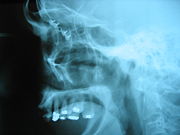
Because it is biocompatible (non-toxic and is not rejected by the body), titanium is used in a gamut of medical applications including surgical implements and implants, such as hip balls and sockets ( joint replacement) that can stay in place for up to 20 years. Titanium has the inherent property to osseointegrate, enabling use in dental implants that can remain in place for over 30 years. This property is also useful for orthopedic implant applications.
Since titanium is non- ferromagnetic, patients with titanium implants can be safely examined with magnetic resonance imaging (convenient for long-term implants). Preparing titanium for implantation in the body involves subjecting it to a high-temperature plasma arc which removes the surface atoms, exposing fresh titanium that is instantly oxidized. Titanium is also used for the surgical instruments used in image-guided surgery, as well as wheelchairs, crutches, and any other product where high strength and low weight are important.
Its inertness and ability to be attractively colored makes it a popular metal for use in body piercing. Titanium may be anodized to produce various colors. A number of artists work with titanium to produce artworks such as sculptures, decorative objects and furniture.
Compounds
The +4 oxidation state dominates in titanium chemistry, but compounds in the +3 oxidation state are also common. Because of this high oxidation state, many titanium compounds have a high degree of covalent bonding.
Star sapphires and rubies get their asterism from the titanium dioxide impurities present in them. Titanates are compounds made with titanium dioxide. Barium titanate has piezoelectric properties, thus making it possible to use it as a transducer in the interconversion of sound and electricity. Esters of titanium are formed by the reaction of alcohols and titanium tetrachloride and are used to waterproof fabrics.
Titanium nitride (TiN) is often used to coat cutting tools, such as drill bits. It also finds use as a gold-coloured decorative finish, and as a barrier metal in semiconductor fabrication.
Titanium tetrachloride (titanium(IV) chloride, TiCl4, sometimes called "Tickle") is a colourless liquid which is used as an intermediate in the manufacture of titanium dioxide for paint. It is widely used in organic chemistry as a Lewis acid, for example in the Mukaiyama aldol condensation. Titanium also forms a lower chloride, titanium(III) chloride (TiCl3), which is used as a reducing agent.
Titanocene dichloride is an important catalyst for carbon-carbon bond formation. Titanium isopropoxide is used for Sharpless epoxidation. Other compounds include; titanium bromide (used in metallurgy, superalloys, and high-temperature electrical wiring and coatings) and titanium carbide (found in high-temperature cutting tools and coatings).
Isotopes
Naturally occurring titanium is composed of 5 stable isotopes; 46Ti, 47Ti, 48Ti, 49Ti and 50Ti with 48Ti being the most abundant (73.8% natural abundance). Eleven radioisotopes have been characterized, with the most stable being 44Ti with a half-life of 63 years, 45Ti with a half-life of 184.8 minutes, 51Ti with a half-life of 5.76 minutes, and 52Ti with a half-life of 1.7 minutes. All of the remaining radioactive isotopes have half-lives that are less than 33 seconds and the majority of these have half-lives that are less than half a second.
The isotopes of titanium range in atomic weight from 39.99 u (40Ti) to 57.966 u (58Ti). The primary decay mode before the most abundant stable isotope, 48Ti, is electron capture and the primary mode after is beta emission. The primary decay products before 48Ti are element 21 (scandium) isotopes and the primary products after are element 23 (vanadium) isotopes.
Precautions
Titanium is non-toxic even in large doses and does not play any natural role inside the human body. An estimated 0.8 milligrams of titanium is ingested by humans each day but most passes through without being absorbed. It does, however, have a tendency to bio-accumulate in tissues that contain silica. An unknown mechanism in plants may use titanium to stimulate the production of carbohydrates and encourage growth. This may explain why most plants contain about 1 part per million (ppm) of titanium, food plants have about 2 ppm and horsetail and nettle contain up to 80 ppm.
As a powder or in the form of metal shavings, titanium metal poses a significant fire hazard and, when heated in air, an explosion hazard. Water and carbon dioxide-based methods to extinguish fires are ineffective on burning titanium; Class D dry powder fire fighting agents must be used instead.
Even bulk titanium metal is susceptible to fire, when it is heated to its melting point. A number of titanium fires occur during breaking down devices containing titanium parts with cutting torches.
When used in the production or handling of chlorine, care must be taken to use titanium only in locations where it will not be exposed to dry chlorine gas which can result in a titanium/chlorine fire. Care must be taken even when titanium is used in wet chlorine due to possible unexpected drying brought about by extreme weather conditions.
Titanium can catch fire when a fresh, non-oxidized surface gets in contact with liquid oxygen. Such surfaces can appear when the oxidized surface is struck with a hard object, or when a mechanical strain causes the emergence of a crack. This poses the possible limitation for its use in liquid oxygen systems, such as those found in the aerospace industry.
Salts of titanium are often considered to be relatively harmless, but its chlorine compounds, such as TiCl2, TiCl3 and TiCl4, have presented several unusual hazards. The dichloride takes the form of pyrophoric black crystals, and the tetrachloride is a volatile fuming liquid. All of titanium's chlorides are corrosive.

